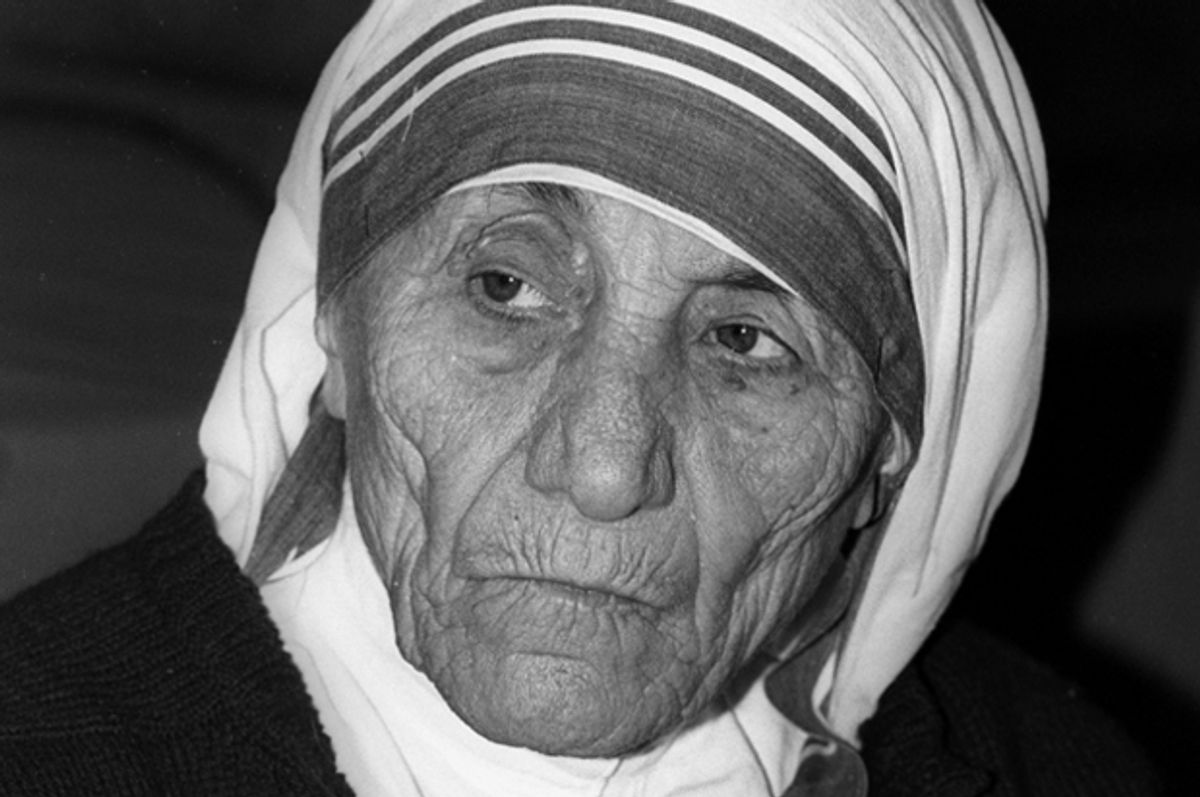Very few people have the honor of getting promoted long after they're dead, but if that's the kind of ambition you possess, may I recommend first being Catholic?
In the least surprising announcement since Ben and Jen's divorce, the Vatican confirmed Tuesday that it will canonize Mother Teresa in September, nineteen years to the day after her death. That's SAINT Teresa to you now! Because the Calcutta missionary and nun was alive within the memory of many of us — as a public figure, as a Nobel Peace Prize winner, as a frequent target of the scathing vitriol of the late Christopher Hitchens — her trajectory to sainthood feels remarkably fast-tracked. And it is.
A polarizing figure both in life and death — Mother Teresa devoted her life to working with the poorest of the poor, yet her charity was dogged by accusations of misuse of funds and "rather dubious way of caring for the sick" — she has proven no less controversial in the nearly two decades since her death. Yet so indelible is the mark she made that her name alone has become a shorthand for someone almost too self-sacrificing to be believed. And when it comes to big ticket names in modern Catholicism, well, she's number one. No wonder then that she'd barely shuffled off the mortal coil when the work of officially putting a halo on her began.
For those of us who fancy ourselves chill Catholics — we like our more socially progressive pope and we're still toughing it out and pushing for greater reforms — watching the process of designating someone a saint will remind us that this religion has some serious WTF aspects. We may casually use the word "saint" to describe anyone behaving decently, but real, official sainthood itself is a dark ages concept. Early Church martyrs and holy people were recognized and remembered, but more informally. Then in the 11th century, Pope Urban II found himself at the center of a dispute over the "alleged sanctity and miracles" of a deceased bishop — a dispute that endured through several of his successors. Around 1170, Pope Alexander III put his foot down and declared that only the pontiff had the authority to declare someone a bona fide saint.
And what makes a saint? The criteria have been tweaked over the centuries but the gist has remained largely the same. First, the person must attain the entry level of beatification, which is when the church formally affirms that he or she is in heaven. What proves that someone is heaven, you ask? Why, miracles, of course. At least two. This is where the living have to step up. They ask the would-be saint, at this point probably but not decisively in heaven, to intercede to God on a particular matter. If it happens — and it should be a biggie — and the Vatican confirms it, it's green lights ahead for sainthood.
In 1999, Pope John Paul II waived the normal five-year waiting period for getting the ball rolling on these things and opened up Mother Teresa for immediate consideration for canonization. Then in 2002, the Vatican affirmed that an Indian woman was cured of an abdominal tumor through the intercession of Mother Teresa. The woman herself later accused Mother Teresa's Sisters of Charity of abandoning her and her family to a life of "penury," but Teresa was beatified in 2003. John Paul II, by the way, was pretty canonization-happy — he sainted more people than all his predecessors combined.
But last year, Pope Francis recognized another miracle from Teresa — the healing of a Brazilian man with a brain infection. After that, the Vatican announced Teresa would be canonized, but not when.
Saints, in addition to enjoy the perks of being indisputably declared to be enjoying an awesome afterlife, are believed to have an inside track with the Big Man. This is why Catholics pray to saints — and believe some are more effective at others, especially with regard to certain specific requests. You want God to help you find something you lost? Ask St. Anthony to put in the good word. Everything a bust? St. Jude's the guy for hopeless cases. Now, with her own canonization fully in the works, Teresa officially joins the heavenly choir, no doubt currently figuring out what her intercessory "thing" will be. And while most saints take a good century or so to attain her imminent status, Mother Teresa is still proving herself an achiever, even in the afterlife.

Shares